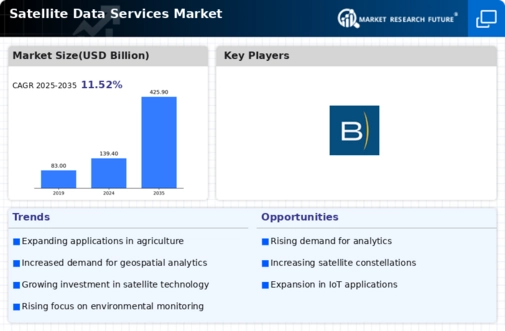Top Industry Leaders in the Satellite Data Services Market

Strategies Adopted:
Constellation Expansion: Key players in the satellite data services market invest in expanding their satellite constellations to enhance coverage, revisit rates, and data collection capabilities, enabling more frequent and timely monitoring of the Earth's surface.
Advanced Analytics: Companies focus on developing advanced analytics algorithms and data processing techniques to extract actionable insights from satellite imagery, including change detection, object identification, and trend analysis, to address diverse customer needs and use cases.
Vertical Integration: Vertical integration of satellite manufacturing, launch services, ground stations, and data analytics enables companies to streamline operations, control costs, and deliver end-to-end solutions for customers, from data acquisition to actionable intelligence delivery.
Strategic Partnerships: Collaboration with government agencies, commercial partners, research institutions, and industry stakeholders is essential for key players to expand market reach, access new customers and markets, and leverage complementary capabilities and resources.
Key Companies in the satellite data services market include
- Airbus SE (Netherlands)
- Black sky (US)
- Digitalglobe InC (US)
- Earth-i Ltd (UK)
- Geospatial Intelligence Pty Ltd (Australia)
- Gisat SRO (Czech Republic)
- Harris Geospatial Solutions Inc (US)
- Imagesat International (Israel)
- Planet Labs Inc (US)
- Trimble Inc (US)
Factors for Market Share Analysis:
Data Quality and Resolution: Market share analysis considers the quality, resolution, accuracy, and currency of satellite data products and services offered by companies, as well as their ability to meet customer requirements for specific applications and use cases.
Product Portfolio and Customization: The breadth and depth of companies' product portfolios, including satellite imagery, data analytics, and value-added services, as well as their ability to customize solutions to address customer needs and preferences, influence market share and customer satisfaction.
Customer Relationships: Strong relationships with government agencies, defense organizations, commercial enterprises, and other customers, based on trust, reliability, and performance, are key factors in winning business and retaining market share in the competitive landscape.
New and Emerging Companies:
Capella Space: Capella Space is a startup that offers synthetic aperture radar (SAR) satellite imagery and analytics services, providing all-weather, day-and-night monitoring capabilities for applications such as maritime surveillance, infrastructure monitoring, and disaster response.
Iceye: Iceye specializes in SAR satellite imaging and analytics, operating a constellation of microsatellites to deliver high-resolution imagery and timely insights for defense, maritime, and environmental monitoring applications.
Umbra Lab: Umbra Lab is developing a constellation of SAR microsatellites to provide high-resolution imaging and analytics services for defense, intelligence, and commercial customers, focusing on rapid revisit rates and real-time monitoring capabilities.
Industry News and Current Company Investment Trends:
Launch of Next-Generation Satellites: Companies in the satellite data services market are investing in the development and deployment of next-generation satellites with advanced imaging sensors, higher resolution capabilities, and enhanced data processing capabilities to meet evolving customer needs and market demands.
Expansion of Analytics Capabilities: There is a growing emphasis on expanding analytics capabilities and data processing infrastructure to support real-time monitoring, predictive analytics, and automated insights generation from satellite data, enabling more efficient decision-making and actionable intelligence delivery.
Integration of Artificial Intelligence (AI) and Machine Learning (ML): Companies are integrating AI and ML algorithms into their satellite data analytics platforms to automate data analysis, identify patterns, detect anomalies, and extract actionable insights from large volumes of satellite imagery, enhancing productivity, accuracy, and scalability.
Overall Competitive Scenario:
The satellite data services market is characterized by intense competition among key players, driven by technological innovation, market demand, and regulatory considerations. Companies differentiate themselves through their satellite constellation capabilities, data processing infrastructure, analytics algorithms, and customer relationships. New entrants and emerging companies aim to disrupt the market with innovative technologies, business models, and value propositions tailored to specific market segments and customer needs. Collaboration, innovation, and customer-centricity are key drivers of success in the dynamic and competitive satellite data services market.
Satellite Data Services Industry Developments
For instance,July 2022
Northrop Grumman has contracted Airbus U.S. Space & Defense, Inc. to provide 42 satellite platforms as well as assembly, integration, and test (AIT), launch, and space vehicle commissioning support services to fulfill the Tranche 1 Transport Layer prototype constellation (T1TL) award from the United States Space Development Agency (SDA).
For instance,February 2023
BlackSky is embedding the Inmarsat and Addvalue inter-satellite data relay technology, IDRS, into its next-generation satellite architecture. Addvalue has developed a novel Low-Earth Orbit (LEO) satellite antenna system that provides complete communications coverage when satellites are not visible to a base station. The IDRS terminal makes advantage of Inmarsat's satellite network to provide LEO satellites with continuous communications for mission tasking and data monitoring.


